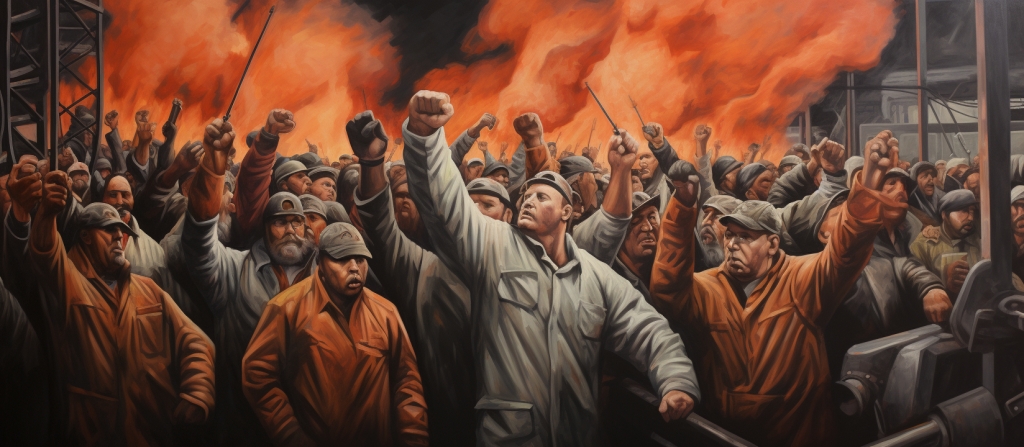UAW: What We Stand To Gain, Vs. Lose, From The Threat Of A Strike.
The UAW is ready to strike, and it feels as though the entire state of Michigan is on edge. One commenter asked why the media persists in framing the question of what a strike will cost the economy in negative terms, versus what the economy could stand to win if the Big 2.5 met their demands. It’s an interesting question, certainly, and it’s one that’s hard to answer. So, let’s have a look.

The Basics. A strike is not unlikely to send the entire state of Michigan into a recession. In spite of the fact that the auto industry is increasingly automated and increasingly decentralize versus the auto industry of yore, Michigan still clings to it like a well-worn stuffed animal it can’t seem to part with. We continue to spend billions of dollars each year to subsidize the automakers, who justify this lavish subsidy no longer simply by the promises of “job creation,” but increasingly by “job retention.” In other words, “if you guys don’t keep paying us money, we’ll take our plants and leave!” Suffice it to say that a lot of people aren’t sympathetic to the plight of a trio of multi-billion dollar, heavy industrial manufacturers that haven’t always been the best citizens.
The Math. There are 156,000 members that would be covered by a strike. One might also imagine that there’s the possibility of sympathetic labor actions, the threat of which we’ve seen in recent strikes from UPS and other. Let’s imagine that 156,000 people are suddenly earning $23.40 an hour instead of $18.00 an hour. Of course, plenty are earning more than that, but that’s a nice, round number to start! That works out to $842,400 additionally earned every hour worked by UAW membership at full employment. Working 40 hours a week for 49 weeks per year, that’s roughly 2000 hours, so, $1.685 billion per year. Assuming a marginal propensity to consume of 0.80 (meaning that workers spend 80% of their money and save 20%– remember this article?), this translates to an economic impact of $8,424 billion per year. That’s a bump to the state’s economy of about 1.3% in terms of impact on GDP.

Checking The Math. The UAW is not a top-paid union, nor is Michigan a particularly wealthy state. This comes from having been beaten down by the automakers over the years who continue to ship jobs both overseas and to the lower-wage, lower-regulation South, but also from the general depression of working class wages in this country over the past 40 years. The average pay tops out at $32.32 an hour, and there are plenty of jobs that don’t even pay a living wage (Stellantis plant expansion, anyone?). So, it’s fair to say that probably most workers are making more than $18 an hour to begin with, but that’s still an OK average to guestimate, with estimates on average wages in Michigan ranging from $16.32 an hour to $19.11 per hour.
Disclaimers. This is some grossly simplified napkin math, but it’s worth talking about during a time when our governor is really interested in assembling gaggles of really wealthy, old, white people to talk about how to keep young people in the state. While I don’t particularly think of the UAW as being a young group of people, and I suspect that most of them are probably not going to reinvest that additional money into fixing up old houses on the westside of Detroit (as opposed to, say, moving to Ron DeSantis Country with the savings), we can’t really factor my personal anecdotal interpretations or snark into the economic multiplier (thank goodness). In other words, we can count on a multi-billion dollar boost to Michigan’s economy if the UAW gets what it wants.
$8.424 billion per year translates to a lot of new tax revenue for the state and her municipalities (hundreds of millions of dollars in tax revenue!), a lot of personal spending (tens of thousands of jobs created!), and, inevitably, the sale of a lot of new cars (however you slice it, I’m sure this would translate to the purchase of tens of thousands of new vehicles). I’ve raised this point before in thinking about why the Big 2.5 should be interested in promoting transit investment– because it saves people money and then, at some point, they’ll have enough money to buy their own car. It’s not just idle dreaming– it’s math. If only we were as focused on the potential positive outcomes as we are on the negative? Of course, the full amounts of the raises amount to tiny fractions of these companies’ total annual profits, which, let’s remember a few years ago, they were bragging about as having broken records. The more things change, the more they stay the same, or whatever. At the least, we can try and change how we talk about the outcomes.





